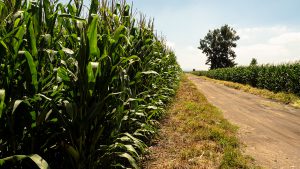Overcoming obstacles
AGRICULTURAL GROWTH IN BRAZIL

BRAZIL’S PROFIT MARGINS on corn and soybean production are limited by infrastructure and logistic constraints. However, agriculture is an economical hot spot with continued growth despite supply chain issues, unpredictable weather patterns, and large export taxes.
High profit margins, a depreciating currency in comparison to the U.S. dollar, improvements in infrastructure and logistics, cheap production costs, and a multitude of financing options are some of the reasons that Brazil continues to see growth.
Soybean production is expected to reach 134 million tonnes and corn production is estimated at 103 million tonnes in the 2020/2021 season.
The planted area of both soybeans and corn is up since the 2019/2020 season with 95 million acres (up four per cent) and 47 million acres (up five per cent) planted, respectively.
PROFITS
“Profit margins are reaching record levels,” says Marcos Rubin of Agroconsult. Rubin was a presenter during the ‘Bringing you What’s Next — South America Edition’ virtual series hosted by FS PARTNERS and Great Lakes Grains.
“Commodity prices in Brazil have doubled in the past year and a half,” says Rubin. He notes the depreciating Brazilian currency makes their commodities cheap to purchase on international markets and increases the global market.
Soybean exports peaked in 2020 at 91 million tonnes which is up 25 per cent from 2019. But soybean exports have fallen to 84 million tonnes in 2021; down by eight per cent since 2020.
Rubin says that the Brazilian government has imposed a large export tax on soybeans which hinders farmers abilities to expand their farms.
Corn exports peaked in 2019 at 39 million tonnes and fell 15 per cent to 33 million tonnes in 2020. Corn exports have increased from 2020 to 2021 by six per cent, to 35 million tonnes.
Rubin says that unlike soybeans, the Brazilian government has imposed programs to increase their corn exports.
LOGISTICS
Logistics have been a long-term bottleneck for corn and soybean exports in Brazil due to the rapid expansion of agriculture. Over the past 10 years, several notable improvements have been made. The ports in the northern region, where large-scale farms are located, have received significant upgrades and exports from them have grown 20 per cent since 2010. The lower transportation costs have increased overall profit margins for these farmers.
Since 2017, the cost of getting soybeans to port has been lower in Brazil than in the U.S. In 2021, the cost to get soybeans to port in Sorriso, Brazil is estimated to be USD $1.2/bu and USD $1.6/bu in Iowa.
Roads and railways have seen improvements in the past five years. However, this is still an area that is being continually improved as a means to get corn and soybeans to port as quickly and efficiently as possible.
Rubin states that while profit margins are high and continue to grow, Brazilian farmers find themselves running into capacity issues. Farmers wish to expand their production but are not able to due to capacity limitations in addition to the rising costs of land.
As logistics and infrastructure improvements are made, exporting corn and soybeans becomes easier and export numbers in Brazil will increase.
YIELD INCREASES
Rubin points out that one of the largest areas for improvement on farm in Brazil is through yield increases. Soybean yield is expected to reach 52 bushels per acre (bu/ac) up two per cent from 2019/2020 and corn yield is expected to reach 86 bu/ac which is down four per cent from last season.
Brazil uses the highest tech available to them in the form of seeds, crop inputs, and technology; however, Rubin identifies yields as an area for improvement among Brazilian farmers.
Another issue that Brazilian corn and soybean farmers are facing is their inability to sell their crop well. “There is a 50 per cent difference between contract prices and cash prices,” says Rubin.
Caitlin Kroetsch is the communications coordinator co-op for Grain Farmers of Ontario. •


























